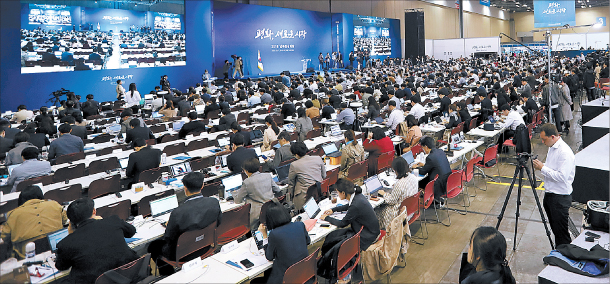Eyes of the world are watching Panmunjom

Reporters from Korea and around the world take their seats on Thursday at the main press center in Kintex, Gyeonggi, to prepare for the inter-Korean summit today. [JOINT PRESS CORPS]
As of Tuesday, 460 media outlets from 41 countries have registered to cover today’s inter-Korean summit, the Blue House said, far exceeding coverage of the previous two summits held in 2000 and 2007.
Most of the reporters will be based in the 2018 Inter-Korean Summit Press Center, a makeshift facility housed inside Kintex, a convention center in Goyang, Gyeonggi. The press center is over 10,000 square meters (107,000 square feet), the size of a football stadium, and will operate around the clock through Saturday morning. It officially opened on Thursday.
The main briefing room has around 1,000 seats, with 550 allocated for Korean media, 360 for foreign correspondents and 150 unassigned. The Blue House will brief reporters as the summit kicks off on the southern side of the border village of Panmunjom. The meeting will be broadcast live.
There are 1,981 registered reporters, camera operators and photographers from 176 Korean media outlets, and 869 journalists from 184 foreign media outlets. On-site registration is allowed, so the final figure could well exceed 3,000.
Aside from the PyeongChang Winter Games earlier this year, when about 13,000 journalists covered the international sporting event, the summit pool represents the largest group of journalists gathered in Korea.
During the first inter-Korean summit between South Korean President Kim Dae-jung and North Korean leader Kim Jong-il in 2000, about 1,000 journalists covered the event.
At the second summit between South Korean President Roh Moo-hyun and Kim Jong-il in 2007, there were about 1,700 journalists. During both summits, the main press center was set up at the Crystal Ballroom in central Seoul’s Lotte Hotel and had about 400 seats.
At the 2000 summit, there were 543 foreign correspondents from 160 media outlets in 28 countries. At the 2007 summit, there were 376 foreign journalists from 90 media outlets in 16 countries. According to the Blue House, of the record number of foreign correspondents covering this year’s event, Japan had the highest number, with 366 reporters from 25 media outlets, followed by the United States with 141 reporters from 28 outlets and China with 81 journalists from 21 outlets.
All briefings at the press center will be simultaneously interpreted in nine languages including Arabic, Chinese, English and Spanish. English-language press releases will be distributed, the organizing committee said, and about 65 multilingual staff members will be on hand.
Several government agencies, including the Ministry of Foreign Affairs; Ministry of Unification, which handles relations with the North; Ministry of Culture, Sports and Tourism; and the Blue House, have set up situation rooms in the press center.
Im Jong-seok, President Moon’s chief of staff and chairman of the organizing committee, gave his first briefing at Kintex on Thursday morning.
The summit marks the first time that foreign correspondents will be part of the press corps covering the inter-Korean summit on site at Panmunjom, the Blue House said. Journalists from the U.K.-based Reuters, U.S.-based Bloomberg, China’s Xinhua and Japan’s Kyodo News and Jiji Press will join Korean media to cover the event from the southern side of Panmunjom.
Foreign media outlets were not able to participate in on-site coverage during the 2000 and 2007 summits, which were both held in Pyongyang.
The joint press corps at Panmunjom comprising 18 Korean journalists and five foreign correspondents will operate out of a small press room at the Freedom House, about 130 meters (426 feet) away from the Peace House where Moon and Kim are meeting.
KT will be the official telecom service provider for the summit, offering its high-speed 5G cellular service at Panmunjom and Kintex. The press briefing at Panmunjom directly following the summit will be streamed live to the press center in 360-degree video through the 5G network.
On the eve of the inter-Korean summit, South Korea’s ruling and opposition parties were united in wishing for the success of Moon and Kim’s first meeting, though they struck different tones aligning with their ideological perspectives.
In a National Assembly meeting, Woo Won-sik, floor leader of the ruling Democratic Party, said, “We request that the opposition parties halt their confrontations for bipartisan cooperation to contribute to peace and national interests on the Korean Peninsula.”
Kim Sung-tae, floor leader of the main opposition Liberty Korea Party, which has been hawkish on North Korea, said, “Rather than being carried away by emotions, we need to make sure that North Korea shows sincere action toward scrapping its nuclear weapons program and keeping the peace regime on the Korean Peninsula. President Moon and his government officials have to maintain calmness and internal stability as they face the summit.”
“Unlike the two previous inter-Korean summits, where the actual meeting between the South and North’s leaders was in itself meaningful, it is meaningful in this summit to create a new inflection point in inter-Korean relations,” he added. “This summit, which is happening in advance of the North-U.S. summit, will have an immense effect on keeping peace and order in Northeast Asia.”
BY SARAH KIM [kim.sarah@joongang.co.kr]










with the Korea JoongAng Daily
To write comments, please log in to one of the accounts.
Standards Board Policy (0/250자)